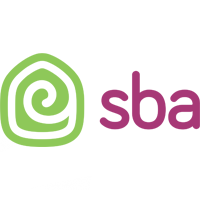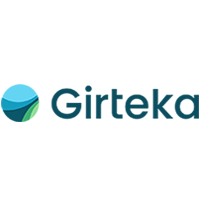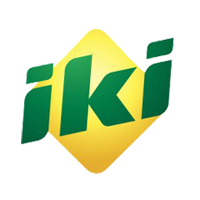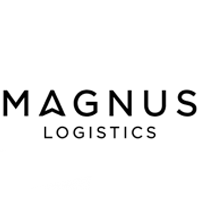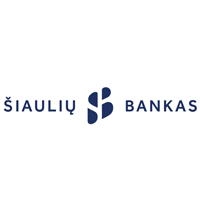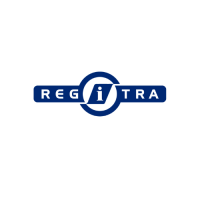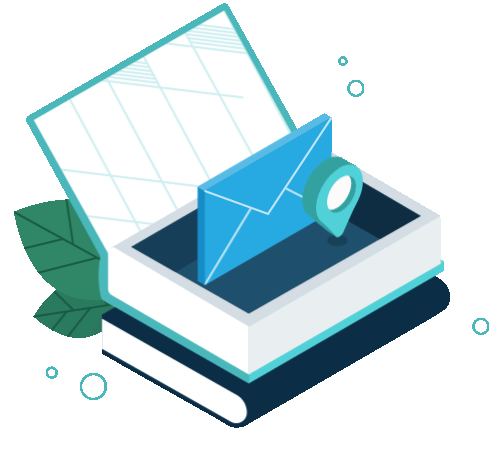E.mokymai (nuotoliniai mokymai) – virtualioje erdvėje pateikiama mokymosi medžiaga, skirta savarankiškam mokymuisi ir parengta naudojant skaitmenines technologijas, siekiant praturtinti mokymosi patirtį bei patenkinti besimokančiojo poreikius.
Kas yra e.mokymas?
E.mokymai – virtualioje erdvėje pateikiama mokymosi medžiaga, skirta savarankiškam mokymuisi ir parengta naudojant skaitmenines technologijas, siekiant praturtinti mokymosi patirtį bei patenkintibesimokančiojo poreikius.

E. mokymų nauda
Efektyvus informacijos perdavimas
E. mokymai yra ruošiami ekspertams bendradarbiaujant su turinio dizaineriais, kurie užtikrina mokymų tikslų įgyvendinimą, medžiagos aiškumą, parinktų mokymosi metodų efektyvumą ir tęstinumą.
Laiko ir finansinių kaštų optimizavimas
Sukurti online mokymai lieka organizacijoje neribotą laiką, todėl išvengiama pasikartojančių mokymų organizavimo iššūkių ir sumažinamos pasikartojančios organizacijos išlaidos. Laiko ir finansines sąnaudas paskaičiavome ČIA.
Interaktyvus savarankiškas mokymasis
Elektroniniai mokymai yra papildyti intuityvia navigacija, interaktyviomis užduotimis ir atvejų analizėmis, kurios padeda organizacijos darbuotojams labiau įsisavinti mokomąją medžiagą, simuliuojant realias situacijas.
Organizacijos informacijos banko papildymas
E. mokymas turi ilgalaikę išliekamąją vertę, nes besimokančiajam užtenka turėti vieną prisijungimą prie mokymosi platformos, kurioje, kartu su e. mokymais, yra visa likusi organizacijoje naudojama ugdomoji medžiaga.
E. mokymų prieinamumas
Emokymai yra prieinami bet kuriuo, besimokančiajam patogiu, metu ir bet kurioje vietoje. Jie gali būti sukuriami arba atnaujinami norima kalba, visiems besimokantiesiems siekiant suteikti lygiavertiškas galimybes ugdyti organizacijai svarbias kompetencijas.
E. mokymų formato įvairumas
E. mokymuose naudojamas ne vienas informacijos pateikimo būdas, užtikrinantis stipresnį mokomosios medžiagos įsisavinimą per schemas, iliustracijas, vaizdo įrašus, rašytinį tekstą ir užduotis.
Formatai

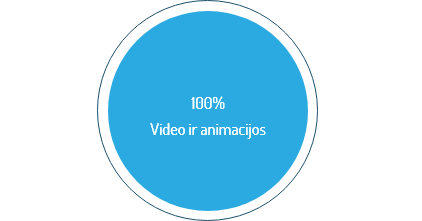
Mokomieji filmukai
Vaizdo įrašai, kuriuose ekspertai ar užkadrinis balsas pristato mokomąją medžiagą. Mokomieji filmukai gali būti papildyti animacijomis ir svarbią informaciją akcentuojančiais tekstais ir grafiniais elementais.

Interaktyvios skaidrės
Intuityviai naviguojamos mokomosios skaidrės, kuriose papildomai pridėti interaktyvūs elementai užtikrina aktyvų mokinio dalyvavimą, savarankiškai pažindinantis su mokymų turiniu.
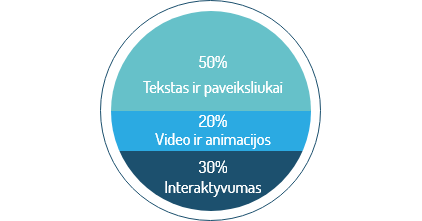
Interaktyvūs puslapiai
Interaktyvūs mokymai, primenantys naršymą interneto tinklapyje. Turinys pateikiamas nedideliais fragmentais, o jo pagrindą sudaro tekstas su įterptomis iliustracijomis, animacijomis ir interaktyviais elementais.
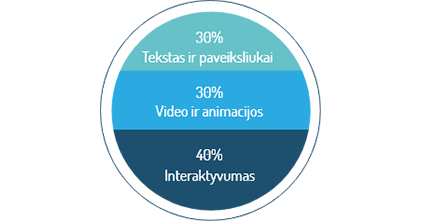
Interaktyvūs mokomieji filmukai
Populiariausias e. mokymų formatas, kuriame mokomoji medžiaga kombinuojama su besimokantįjį įtraukiančia istorija. Įgytos žinios čia pat taikomos interaktyviose užduotyse ir klausimuose.
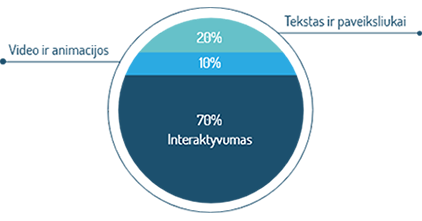
Programų simuliacijos ir mokomieji žaidimai
Simuliacijos, leidžiančios praktiškai išbandyti įvairius darbo procesus bei patirti jų pasekmes. Sužaidybintas mokymas sudėtingą mokymąsi paverčia smagiu užsiėmimu.Formatai


Mokomieji filmukai
Vaizdo įrašai, kuriuose ekspertai ar užkadrinis balsas pristato mokomąją medžiagą. Mokomieji filmukai gali būti papildyti animacijomis ir svarbią informaciją akcentuojančiais tekstais ir grafiniais elementais.

Interaktyvios skaidrės
Intuityviai naviguojamos mokomosios skaidrės, kuriose papildomai pridėti interaktyvūs elementai užtikrina aktyvų mokinio dalyvavimą, savarankiškai pažindinantis su mokymų turiniu.

Interaktyvūs puslapiai
Interaktyvūs mokymai, primenantys naršymą interneto tinklapyje. Turinys pateikiamas nedideliais fragmentais, o jo pagrindą sudaro tekstas su įterptomis iliustracijomis, animacijomis ir interaktyviais elementais.

Interaktyvūs mokomieji filmukai
Populiariausias e. mokymų formatas, kuriame mokomoji medžiaga kombinuojama su besimokantįjį įtraukiančia istorija. Įgytos žinios čia pat taikomos interaktyviose užduotyse ir klausimuose.

Programų simuliacijos ir mokomieji žaidimai
Simuliacijos, leidžiančios praktiškai išbandyti įvairius darbo procesus bei patirti jų pasekmes. Sužaidybintas mokymas sudėtingą mokymąsi paverčia smagiu užsiėmimu.Susidomėjote? Peržiūrėkite mūsų darbų biblioteką

Mūsų e. mokymų kūrimo komanda

Projektų vadovai

Mokymų turinio dizaineriai

Grafikos dizaineriai ir animatoriai

Operatoriai – montuotojai
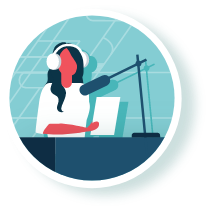
Užkadrinio balso kūrėjai
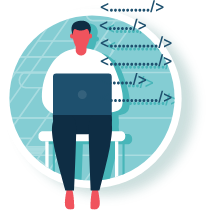
Mokymų programuotojai
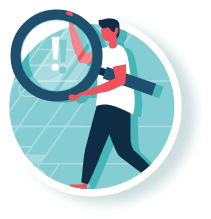
Kokybės užtikrinimo vadybininkai
Kliento atsiliepimas
Norėdami, kad mokymai būtų kuo labiau suprantami ir aiškūs plačiai mūsų kolegų bendruomenei, e. mokymus naudojame netgi keliomis kalbomis.
Bendradarbiaudami su Talentator sukūrėme įtraukiančius, interaktyvius ir į praktines veiklas orientuotus e. mokymus administracijos darbuotojams. Talentator patarimai ir sprendimai bei jų įsipareigojimas žingsnis po žingsnio valdyti projektą lėmė tai, kad turime vieną geriausiai įvertintų mokymų mūsų ugdymo valdymo sistemoje.
Labai tikimės, kad su šiuo interaktyviu e. mokymu išaugs atrankų kokybė ir parduotuvių vadovai daug tvirčiau jausis vykdydami atrankas, darys mažiau klaidų atrankose ir bendrai gerės kandidatų patirtis.
Talentator mokymai leidžia mūsų darbuotojams geriau susipažinti su galimomis smurto ir priekabiavimo formomis, jų prevencijos priemonėmis, pranešimų apie smurtą ir priekabiavimą teikimo bei nagrinėjimo tvarka ir kita informacija, susijusia su mobingo prevencija Banke. Šiuos mokymus jau išklausė 94 proc. mūsų darbuotojų.
Nuotolinis mokymas – tai nėra tik žinių patikrinimas. Tai yra lengvai prieinama mokymų medžiaga, kurią darbuotojas bet kada gali rasti ir dar kartą peržiūrėti vienoje sistemoje.
Galbūt ir dabar dar nesugebame įvertinti, kad nuotoliniai mokymai yra naudingi, efektyvūs, lengvai prieinami, jie neatitraukia žmonių nuo darbo ir sukelia mažiau streso.
Standartizavę mokymų turinį, užtikriname, jog vienoda mokymų metodika, priemonės ir turinys yra taikoma kiekvienam mokymuose dalyvaujančiam gyventojui nepriklausomai nuo jo gyvenamosios vietos.

